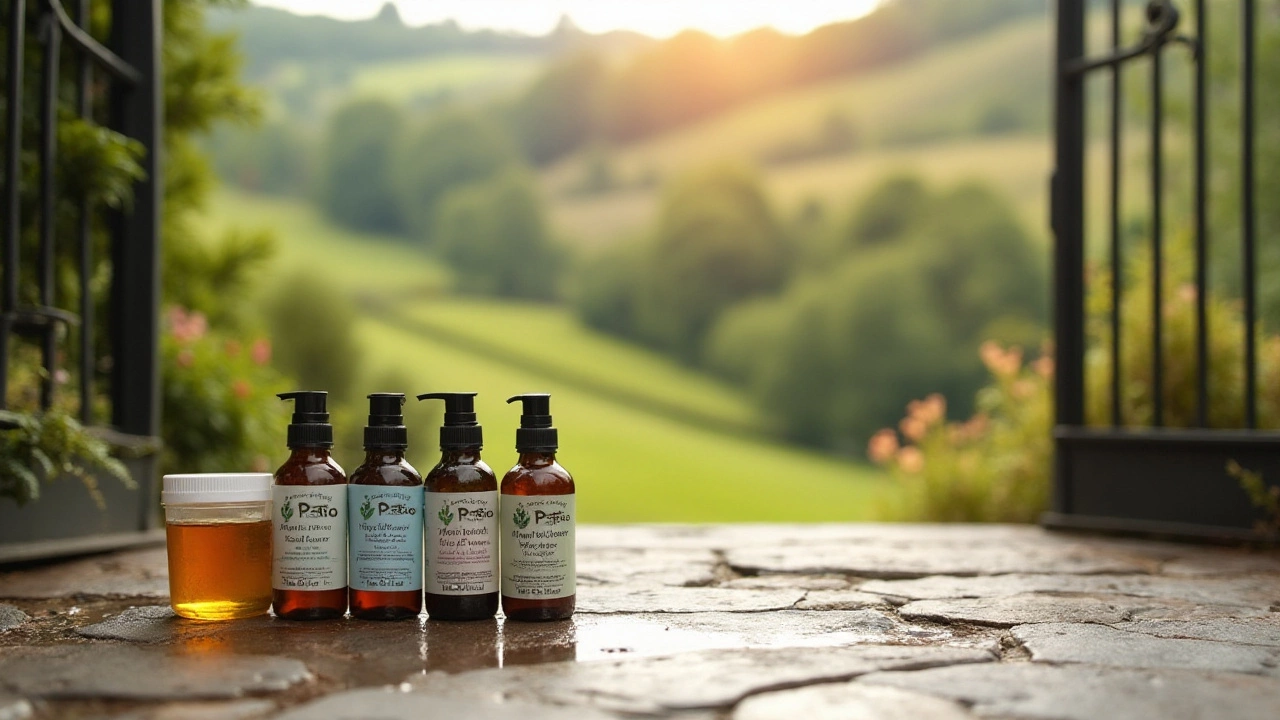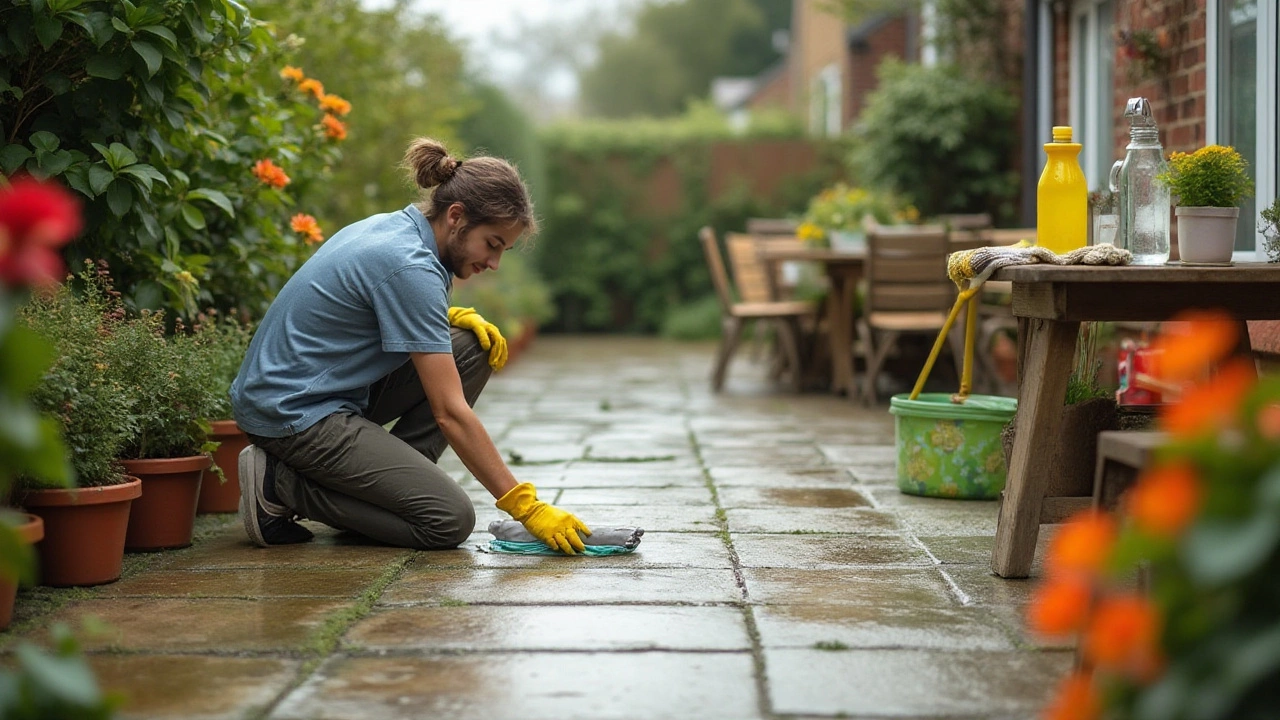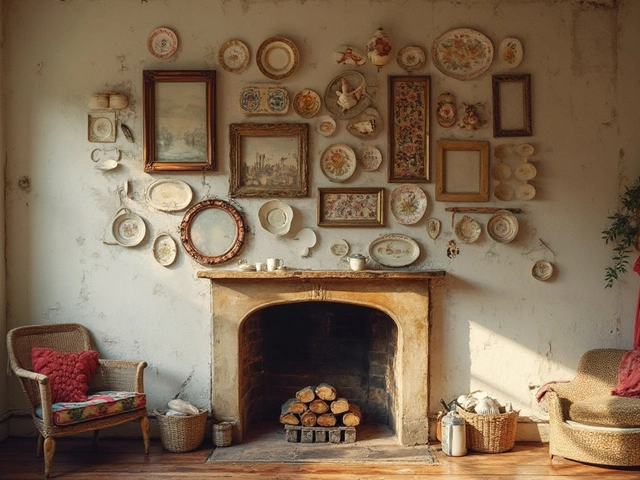An outdoor patio offers a perfect spot to unwind, entertain, or simply enjoy a breath of fresh air. However, the presence of mold can quickly spoil this idyllic setting. Tackling mold not only preserves the aesthetic appeal of your patio but also ensures a healthy environment for you and your family.
In this article, let's unravel the mystery behind mold growth on patios and explore practical ways to remove it effectively. From tried-and-true household remedies to more robust commercial solutions, we'll cover methods to cleanse your outdoor surfaces. Additionally, we'll provide tips on preventing mold from making an unwelcome return. Your patio deserves to be a clean, mold-free extension of your home, and these strategies can help make that a reality.
- Understanding Mold on Patios
- Household Remedies to Remove Mold
- Commercial Mold Removal Products
- Preventing Mold Growth on Patios
- Maintaining a Mold-Free Outdoor Space
Understanding Mold on Patios
When it comes to outdoor spaces, patios are frequently exposed to a variety of elements, making them susceptible to mold growth. This unsightly development can be quite frustrating for homeowners who take pride in their outdoor areas. Mold thrives in environments that are damp, shaded, and have poor air circulation. This makes patios, especially those with wooden decking or concrete surfaces, prime candidates for mold development. Understanding the nature of mold and how it colonizes an area is key to addressing the problem effectively. Mold is not just an aesthetic nuisance; it can also pose health risks by releasing spores into the air, which can aggravate allergies and respiratory conditions.
The science of mold growth is actually pretty straightforward. Mold is a type of fungus that spreads by producing small spores. These spores are light and easily transported through the air, landing on various surfaces where they can germinate under the right conditions. Conditions ideal for mold growth include moisture, warmth, and an organic food source, such as the dirt or dust that can settle on patios. Particularly tedious are areas where water pools, either from rain or lawn sprinkling systems, which provide the dampness mold loves. Pairing this with organic debris like leaves and twigs can accelerate mold development significantly.
A memorable point to consider is the material of your patio. Surfaces such as wood, being porous, can absorb moisture and thus are more prone to mold infestations compared to non-porous materials such as stone or ceramic tiles. Concrete, while not as absorbent as wood, can still harbor mold if it becomes etched or pitted over time, trapping moisture within these imperfected surfaces. It's often said, "An ounce of prevention is worth a pound of cure," and this especially rings true in keeping mold at bay. Taking early precautionary measures can save significant effort later on. You might be surprised to learn that even something as simple as positioning can influence mold growth - patios on the north side of homes, getting less sunlight, tend to suffer more from mold issues.
According to the Environmental Protection Agency (EPA), "The key to mold control is moisture control."This underscores the importance of addressing water management on your patio. It is vital to regularly inspect for leaks or drainage problems that might contribute to mold-friendly conditions. Dealing with mold sooner rather than later ensures the structural integrity of your patio and mitigates health risks associated with inhaling mold spores. Employing good practices in patio maintenance not only aids in mold prevention but also extends the life of your outdoor furniture and surfaces.
In taking these aspects into account, it’s clear that understanding the dynamics of mold can significantly aid in its prevention and removal. Proper awareness about where mold tends to thrive coupled with a proactive stance on moisture management can form a solid defense against this persistent invader. Not only does this knowledge empower you to maintain a comfortable and visually pleasing patio space, but it also enhances the overall health of your area where family and friends gather. Pay attention to the subtle signs early, and with time, mold will be less of a looming concern in your outdoor spaces.
Household Remedies to Remove Mold
Using everyday items found in your home can be an effective approach to tackle the annoying presence of mold on your patio. The solutions we often overlook might just be the key to resolving this persistent issue. Nature's cleanser, white vinegar, is a remarkable weapon in the war against mold. Its natural acidity helps cut through the fungus that clings stubbornly to outdoor surfaces. Spray undiluted white vinegar onto the mold-infested area and let it sit for an hour or so. You'd be amazed at how this simple pantry staple can reduce mold without leaving a toxic residue. After waiting, scrub the area with a brush and rinse with water. For persistent patches, repeat the process. This technique is both cost-effective and environmentally friendly, making it a great option for regular maintenance.
Among household solutions, baking soda deserves a notable mention. It is an excellent non-toxic mold-killer that also helps deodorize your patio. Mixing baking soda with water and creating a paste enables you to apply it directly on the moldy spots. Let it dry before scrubbing it off. This simple concoction not only kills the mold but also prevents it from returning thanks to its residue. Quick tip—store any extra paste in an airtight container for future use; after all, mold is notoriously stubborn! Baking soda is safe around children and pets, showcasing its multifaceted benefits as a go-to household mold remover.
Hydrogen peroxide is another powerful tool straight out of your medicine cabinet. A 3% hydrogen peroxide solution can work wonders as a natural disinfectant on moldy spots. Spray a generous amount over the affected area and allow it to sit for at least ten minutes. The fizzy action of hydrogen peroxide not only cleans but also sanitizes surfaces, unlike bleach, which can be corrosive and harmful. Make sure to scrub the area with a stiff-bristled brush to enhance its mold-killing capacity before rinsing it off with water. Hydrogen peroxide proves to be an effective ally in the fight against mold, without the negativity associated with harsh chemicals.
"Not only is hydrogen peroxide cost-effective, but it's also naturally decomposing into oxygen and water, ensuring no toxic residues," according to a report by the Environmental Protection Agency (EPA).
Lemon juice is not just for making refreshing summer drinks; it's a natural enemy of mold too. Harnessing the power of citrus can provide a fragrant and powerful way to eliminate mold. Lemon juice—freshly squeezed or from a bottle—can be applied directly to small areas of mold. Let it sit before you scrub. Its acidity helps break down mold while leaving behind a pleasant aroma. This, combined with other methods mentioned, can form a solid arsenal against mold resurgence. So, the next time lemons roll out of your fridge, just remember they hold more potential beyond culinary delights.
To round out your household cleaning journey, tea tree oil stands as a potent natural fungicide. Though more of an essential item than a common household ingredient, when added to your anti-mold toolkit, it offers unparalleled effectiveness. Mix a teaspoon of tea tree oil with a cup of water in a spray bottle and mist over the mold. Let it dry without rinsing to maintain the protective layer against mold growth. The strong odor will dissipate in a few hours, but its mold-fighting properties will remain solidified. This essential oil not only eradicates existing mold but also bars new spores from developing—an investment worth making for a long-term mold solution.

Commercial Mold Removal Products
When it comes to battling mold on your patio, sometimes homemade remedies may not be enough. Commercial mold removal products can offer stronger and faster solutions, providing a way to tackle even the most stubborn outbreaks. These products are formulated with ingredients specifically designed to dissolve mold and mildew while preventing their return. One of the most notable options is mold removal sprays, which often include powerful compounds such as sodium hypochlorite, a common household bleach, or hydrogen peroxide. These substances work by breaking down the cell walls of mold, effectively killing it on contact.
While bleach solutions are popular, not all surfaces or users can tolerate them well. This is where products featuring vinegar concentrate become valuable, as they offer a gentler yet potent alternative. Many commercial solutions also feature surfactants, which help break down the biofilm that mold creates to protect itself, allowing cleaning agents to penetrate more deeply. It's important to consider the environmental impact of these solutions. Many companies are developing biodegradable and eco-friendly formulas that still pack a punch against mold while being safer for plants and pets. A growing trend within the industry is the ability to buy mold removal products in concentrated form. This not only reduces packing waste but also allows customers to prepare a customized solution strength based on their specific needs.
"Using specialized mold removers can significantly cut down on both time and effort required for cleaning," says Dr. Emily Evans, a horticultural scientist with a focus on outdoor living spaces. "It's about finding the right balance between efficacy and long-term environmental responsibility."
The selection doesn't end with just liquid solutions. Many homeowners today are choosing mold removal gels and foams for vertical or uneven patio surfaces where liquids tend to run off too quickly to be effective. These gels cling to surfaces longer, ensuring the active ingredients have time to penetrate and do their job. Equally important in any mold eradication effort is the use of products with antifungal properties to keep mold at bay long after the initial cleanup. One good practice is to opt for brands that offer warranties or satisfaction guarantees, indicating confidence in their mold removal capabilities. Explore reviews and trusted garden supply stores to find products with proven reliability.
Preventing Mold Growth on Patios
To keep your patio a place of enjoyment, stopping mold before it takes hold is key. Mold thrives in damp and shady areas, so managing these conditions is your first line of defense. Regularly inspecting your outdoor space for early signs of mold can make a huge difference. By catching it early, you can prevent minor patches from spreading into a major problem. Implement proper drainage solutions if water tends to pool on your patio. Ensure that your patio furniture is not acting as a trap for moisture by using breathable covers that allow air to circulate.
An effective strategy for mold prevention is consistent cleaning and maintenance. Regularly sweep and wash your patio using water and detergent to remove dirt and organic materials that mold feeds on. During seasons when humidity is high, step up your cleaning routine to fend off mold’s favorite environment. Consider using a mixture of borax and water, which acts as a natural mold deterrent when used as a rinsing solution after cleaning. Alternatively, a vinegar solution can also provide natural protection against mold, making it a great eco-friendly option for routine cleaning.
Landscaping choices around your patio can also significantly impact mold growth. Trim back any trees or plants that create excessive shade over your garden furniture and patio area. This allows more sunlight to reach the surface, which naturally inhibits mold formation. Consider designing a layout that encourages air circulation around your patio. By strategically placing plants and furniture, you can ensure that fresh air moves freely, reducing the likelihood of a damp environment.
According to a USDA report, "Good ventilation is essential in mold prevention on outdoor patios and decks. Adequately circulating fresh air limits the ability of mold spores to settle and grow." This simple yet effective change can significantly impact your mold prevention efforts by reducing trapped moisture and humidity.
For those living in particularly humid climates, investing in a portable dehumidifier for areas close to your patio can be a worthwhile consideration. These devices help maintain an optimal humidity level, curbing the conditions under which mold typically thrives. Be sure to check and clean the dehumidifier regularly to ensure its efficiency and effectiveness in keeping the mold in check.
Lastly, consider sealing your patio surface if it is made of porous materials like concrete. A good sealant will not only enhance the appearance of your patio but will also act as a protective barrier against moisture absorption, another key factor in mold prevention. Sealing is an easy DIY project or can be performed by professionals for a more thorough job. Remember to reapply the sealant according to the manufacturer's instructions to maintain its protective benefits.

Maintaining a Mold-Free Outdoor Space
Keeping your patio free from mold not only enhances its beauty but also ensures it remains a safe and inviting space throughout the year. One key aspect of maintenance involves regular cleaning schedules tailored to the needs of your space. By inspecting and cleaning your patio at least once a month, you mitigate mold growth triggered by residues left unnoticed. Begin with a simple sweep to remove leaves and debris, which can retain moisture. Then, periodically wash the surfaces, especially after heavy rainfall or during high humidity periods. Consider using a gentle detergent alongside warm water, scrubbing thoroughly with a brush to dislodge any dirt that could become a breeding ground for mold. This routine, although simple, significantly decreases the likelihood of mold development.
Another crucial step in maintaining a mold-free patio is to ensure that the area is well-ventilated and not subject to prolonged shade. Mold thrives in damp, shaded environments, so it is vital to let sunlight reach your patio as much as possible. Trim back overhanging trees or tall bushes that might be casting shadows and preventing air circulation. If your patio is covered or enclosed, consider installing vents or utilizing outdoor fans to enhance airflow. This approach helps evaporate lingering moisture, reducing the chance of mold spores settling. In the words of Dr. Lawrence Richardson, a noted environmental expert,
"Integrating natural elements like sunlight and airflow into your patio's design is one of the most effective defenses against mold infiltration."Regularly shifting your outdoor furniture can also help; it prevents mold from establishing in the harder-to-clean areas, ensuring that all surfaces receive adequate light and air.
Investing in high-quality, mold-resistant materials can make a significant difference. When choosing furnishings or flooring for your patio, opt for materials expressly designed to withstand outdoor conditions. Treated woods, synthetic fibers, and hardy metals can endure moisture without succumbing to mold. Additionally, applying sealants to porous surfaces creates a barrier against mold spores. Whether you choose a waterproof sealant or a stain-resistant coating, the added layer of protection can extend the lifespan of your furnishings and minimize maintenance efforts. To keep utilization practical, follow the manufacturer’s application instructions, usually recommended every one or two years. Moreover, if your patio requires additional structural improvements, consider installing gutters or a pitched cover to direct rainwater away from your seating area, ensuring dryness.
Finally, integrating preventive measures like using mold inhibitors should not be overlooked. Available in various forms, such as sprays or additives to cleaning solutions, these inhibitors impede mold spore reproduction. An occasional application, particularly during the wetter months or if your region is prone to high humidity, offers another layer of defense. It's wise to perform a patch test first to confirm that these products do not damage or discolor your patio materials. Furthermore, take time to educate yourself and household members about mold signs and prevention strategies. A well-informed family contributes actively to preserving the patio’s condition.
Consistently following these guidelines ensures your patio becomes a bastion against mold. Incorporating a bit of each method into your maintenance routine not only boosts your outdoor space’s resilience but also enhances your enjoyment of every sunlit afternoon or starlit evening right on your doorstep. After all, a proactive approach today saves time and expertise tomorrow. Equipped with these tools and knowledge, you transform your patio into a true outdoor sanctuary.








